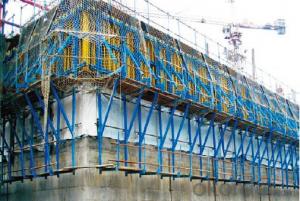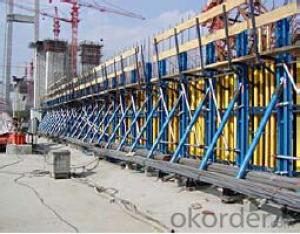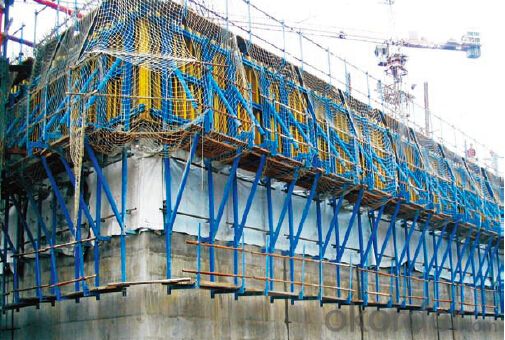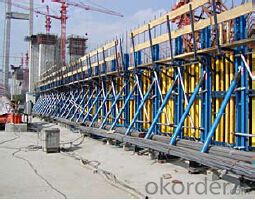Single Side Climbing Bracket for Formwork and Scaffolding system
- Loading Port:
- Tianjin
- Payment Terms:
- TT OR LC
- Min Order Qty:
- 50 m²
- Supply Capability:
- 1000 m²/month
OKorder Service Pledge
OKorder Financial Service
You Might Also Like
Single-side Climbing Bracket SCB180:
With CNBM SCB 180 climbing systems, the loads from the fresh concrete pressure are
transferred through the brackets by means of V-strongbacks and compression braces into the
scaffold anchors.
Typical applications for the SCB 180 are dams, locks, cooling towers, pier heads, tunnels, and
bank vaults.
The formwork is simply tilted backwards when striking takes place. The 1.80 m wide bracket
requires only a minimum of space.
Characteristics:
◆ Economical and safe anchoring
The M30/D20 climbing cones have been designed especially for single-sided concreting using
SCB180 in dam construction, and to allow the transfer of high tensile and shear forces into the still
fresh, unreinforced concrete. Without wall-through tie-rods, finished concrete is perfect.
◆ Stable and cost-effective for high loads
generous bracket spacings allow large-area formwork units with optimal utilization of the bearing
capacity. This leads to extremely economical solutions.
◆ Simple and flexible planning
With SCB180 single-sided climbing formwork, circular structures can also be concreted without
undergoing any large planning process. Even use on inclined walls is feasible without any special
measures because additional concrete loads or lifting forces can be safely transferred into the
structure.
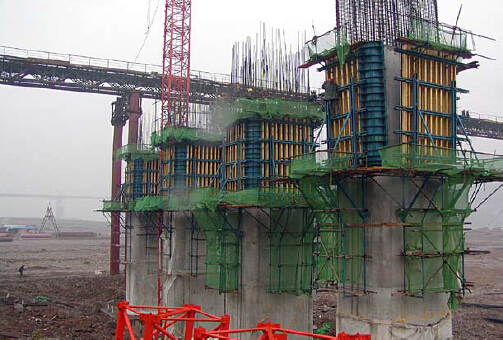
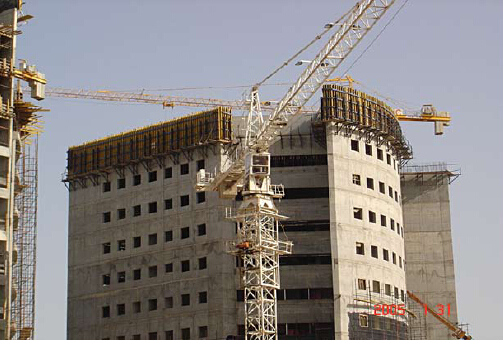
- Q: What are the common challenges associated with steel formwork?
- There are several common challenges associated with steel formwork in construction projects. One of the main challenges is the high initial cost of purchasing or renting steel formwork compared to other types of formwork materials such as wood or plastic. Steel formwork is more durable and has a longer lifespan, but the upfront investment can be a barrier for smaller construction companies or projects with limited budgets. Another challenge is the weight and handling of steel formwork. Steel is a heavy material, which can make it difficult to transport, assemble, and dismantle on the construction site. This can require additional labor and equipment, increasing the overall construction costs. Steel formwork also requires skilled labor for proper installation and alignment. The accuracy and precision of the formwork are crucial for achieving the desired dimensions and finishes of the concrete structures. Any mistakes or misalignments during the setup can lead to costly rework or compromised structural integrity. Maintenance and storage of steel formwork can be challenging as well. Steel formwork needs regular cleaning and treatment to prevent rust and corrosion, especially in humid or coastal areas. Adequate storage space is also required to protect the formwork from external elements when not in use. Lastly, customization and adaptability can be a challenge with steel formwork. Unlike wood formwork, which can be easily cut and shaped on-site, steel formwork requires prefabrication and customization before it can be used. Any changes in the design or dimensions during the construction process may require additional time and cost to modify or replace the steel formwork components. Despite these challenges, steel formwork offers numerous advantages such as durability, reusability, and high-quality finishes. With proper planning, training, and maintenance, these challenges can be effectively managed to ensure successful construction projects.
- Q: Can steel formwork be used for both horizontal and vertical applications?
- Yes, steel formwork can be used for both horizontal and vertical applications. Steel formwork is highly durable and can withstand high pressure and heavy loads, making it suitable for various construction projects. It can be used for horizontal applications such as floor slabs, beams, and foundations, as well as vertical applications like columns and walls. Steel formwork offers flexibility in design and can be easily assembled and disassembled, making it a preferred choice for construction projects that require repetitive use. Overall, steel formwork is a versatile option that can be utilized for both horizontal and vertical applications in construction.
- Q: What are the common connection methods for steel formwork?
- Steel formwork can be connected using several common methods, including welding, bolting, and clamping. Welding is a popular choice due to its ability to create strong and permanent connections by melting two steel components together. However, skilled labor and specialized equipment are necessary for welding. Bolting is another frequently used method, which involves joining steel components using bolts and nuts. This method offers a flexible and adjustable connection, allowing for easy disassembly and reassembly of formwork panels. It is also relatively quick and does not require highly skilled labor. Clamping, on the other hand, utilizes clamps or couplers to connect steel formwork components. This method is often employed for temporary structures or when quick assembly and disassembly are required. Like bolting, clamping provides a flexible and adjustable connection, but it does not require tools or additional hardware. The choice of connection method for steel formwork depends on various factors, such as project requirements, desired level of permanence, ease of assembly, and available resources. Each method has its own advantages and disadvantages, so it is crucial to select the most suitable one based on the specific needs of the project.
- Q: How does steel formwork compare to other formwork materials in terms of cost?
- Compared to timber or plywood, steel formwork generally carries a higher price tag. However, when considering the overall expenses of a construction project, steel formwork has the potential to save costs in the long run. Although the initial cost of steel formwork may be greater, it boasts exceptional durability and can be reused multiple times without compromising its structural integrity. This reusability feature diminishes the need for constant replacement or repair, ultimately reducing the overall expenses for formwork materials in the long term. Furthermore, steel formwork provides unparalleled strength, stability, and precision in shaping concrete structures, resulting in a superior final product. This, in turn, can lead to reduced labor expenses and shorter construction durations, effectively counterbalancing the initial investment in steel formwork. Moreover, steel formwork offers heightened safety due to its fire-resistant properties and ability to withstand extreme weather conditions. This lowers the chances of accidents or damage during the construction process, which can potentially result in savings on insurance costs. Although steel formwork may initially be more costly than alternative materials, it offers a multitude of advantages that can lead to cost savings throughout the entirety of the construction process.
- Q: Is steel formwork suitable for projects with tight deadlines?
- Indeed, projects with tight deadlines can benefit from the use of steel formwork. Its exceptional durability and strength enable it to withstand high pressure and repetitive use. Consequently, it can be reused multiple times without compromising its structural integrity, resulting in faster construction. Furthermore, the assembly and disassembly of steel formwork are effortless, facilitating quick and efficient installation and removal. Its adaptability and versatility make it a suitable choice for construction projects of any scale or complexity. Consequently, incorporating steel formwork into projects with tight deadlines can accelerate the construction process and ensure timely completion.
- Q: Is steel formwork suitable for projects with heavy concrete loads?
- Indeed, steel formwork proves to be exceptionally appropriate for projects that bear heavy concrete loads. Renowned for its strength, durability, and capacity to bear loads, steel formwork emerges as the perfect choice for endeavors entailing substantial concrete loads. Capable of enduring the pressure and weight of concrete, steel formwork ensures the preservation of its structure and integrity throughout the pouring and curing stages. Moreover, steel formwork presents superior dimensional accuracy, facilitating meticulous and consistent concrete placement, a crucial aspect for projects with heavy loads. All in all, steel formwork emerges as a dependable and robust selection for projects necessitating the support of heavy concrete loads.
- Q: Are there any disadvantages to using steel formwork?
- Yes, there are a few disadvantages to using steel formwork. Firstly, steel formwork is generally more expensive to purchase and maintain compared to other types of formwork materials. Additionally, steel formwork is heavier and more difficult to handle and transport, which can increase labor costs and project timelines. Furthermore, steel formwork requires skilled labor for assembly and dismantling, adding to the overall project costs. Lastly, steel formwork may not be suitable for all types of construction projects, especially those involving complex or irregular shapes.
- Q: How does steel formwork affect the aesthetics of a building?
- Steel formwork can significantly impact the aesthetics of a building in several ways. Firstly, steel formwork allows for complex and intricate designs to be created, resulting in visually appealing architectural elements. The flexibility and strength of steel allow for the construction of unique shapes, curves, and patterns that enhance the overall aesthetics of the building. Additionally, steel formwork provides a smooth and seamless finish to the concrete surfaces. This smooth finish contributes to a more refined and polished look, especially when compared to other types of formwork such as timber or plastic. The absence of visible joints, seams, or imperfections on the concrete surfaces enhances the overall appearance of the building. Moreover, steel formwork can be reused multiple times, resulting in cost savings and reduced waste. This economic advantage allows architects and designers to allocate more resources towards enhancing the aesthetics of the building, such as incorporating high-end finishes or unique decorative elements. Furthermore, steel formwork provides a high level of accuracy and precision during the construction process. This precision ensures that the final structure is aligned and symmetrical, enhancing the overall visual harmony of the building. Straight lines, sharp corners, and consistent dimensions can be achieved through the use of steel formwork, resulting in a visually pleasing and harmonious architectural design. Lastly, the durability and strength of steel formwork contribute to the longevity of the building's aesthetics. Steel formwork can withstand harsh weather conditions, resist corrosion, and maintain its structural integrity over time. This durability ensures that the building's aesthetics remain intact for an extended period, enhancing its overall appeal and value. In conclusion, steel formwork positively influences the aesthetics of a building by enabling complex designs, providing a smooth finish, allowing for precision and accuracy, offering cost savings, and ensuring long-lasting visual appeal.
- Q: How does steel formwork contribute to the overall safety of the construction process?
- There are several ways in which steel formwork enhances the safety of the construction process. Firstly, its strength and durability allow it to withstand the weight and pressure exerted during construction, reducing the possibility of formwork failure and subsequent accidents or injuries. Moreover, steel formwork is specifically designed to create a stable and secure structure for pouring concrete. Its precise alignment and tight joints prevent any leakage or seepage of concrete, thus minimizing the chances of structural instability or collapse. This ensures the safety of workers and the overall integrity of the building under construction. Furthermore, steel formwork exhibits high resistance to fire and high temperatures. In the unfortunate event of a fire on the construction site, it acts as a fire-resistant barrier, protecting workers and preventing the spread of fire to other areas. Consequently, the risk of fire-related accidents or injuries is greatly reduced, enhancing the overall safety of the construction process. In addition, steel formwork is designed to be reusable, allowing it to be utilized for multiple construction projects. This not only reduces formwork costs but also minimizes waste and environmental impact. By opting for steel formwork, construction companies can promote sustainability and create a safer construction environment by minimizing the need for constant formwork replacement. In conclusion, steel formwork makes a significant contribution to the overall safety of the construction process by providing strength, durability, stability, and fire resistance. Its precise alignment and tight joints ensure the integrity of the structure being built, diminishing the risk of accidents or collapse. Additionally, its reusability supports sustainability efforts and waste reduction. Overall, steel formwork plays a vital role in establishing a safe and secure construction site.
- Q: How does steel formwork affect the overall safety of a building project?
- Steel formwork can greatly enhance the overall safety of a building project due to its durability, strength, and stability. It provides a solid and secure framework for concrete placement, ensuring proper alignment and support during the construction process. This reduces the risk of structural failures, collapses, or accidents, thereby enhancing the safety of workers and the overall project. Additionally, steel formwork is fire-resistant, which further contributes to the safety of the building as it can withstand high temperatures and prevent the spread of fire.
Send your message to us
Single Side Climbing Bracket for Formwork and Scaffolding system
- Loading Port:
- Tianjin
- Payment Terms:
- TT OR LC
- Min Order Qty:
- 50 m²
- Supply Capability:
- 1000 m²/month
OKorder Service Pledge
OKorder Financial Service
Similar products
Hot products
Hot Searches
